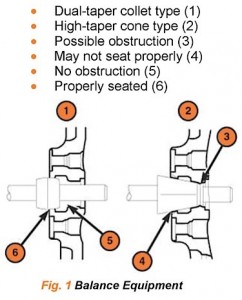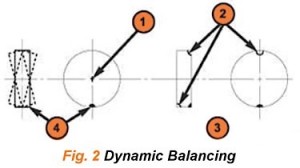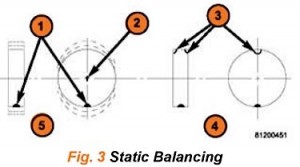Models
2013 Chrysler 200
VISUAL INSPECTION
Visual inspection of the vehicle is recommended prior to road testing or performing any other procedure. Raise and support the vehicle.
Inspect for the following:
• Verify correct (OEM) wheel and tire, as well as presence of wheel weights.
• Inspect tires and wheels for damage, mud packing and unusual wear; correct as necessary.
• Check and adjust tire air pressure to the pressure listed on the label attached to the driver’s door opening.
ROAD TEST
NOTE: If a Noise & Vibration Analyzer is available, use it to diagnose the issue during the road test.
NOTE: If the vehicle has been sitting for an extended period of time, it is recommended to drive the vehicle to warm the tires. This process could eliminate flat spots that can cause vibration.
Road test the vehicle on a smooth road at or near the designated speed that legal speed limits allow. Lightly place hands on steering wheel at the 10 o’clock and 2 o’clock positions and observe for:
• Steering wheel oscillation: clockwise/counterclockwise.
• Steering wheel high-frequency movement: rapid vibration up and down.
• Seat high-frequency movement: rapid vibration up and down.
To rule out vibrations due to brakes or powertrain:
• Lightly apply the brakes at the designated speed; if vibration occurs or is enhanced, vibration is likely due to a brake concern.
• Shift the transmission into neutral while vibration is occurring; if vibration is eliminated, vibration is likely due to a powertrain concern.
NOTE: If wheel balance equipment is capable of testing tire road force variation and the tire/wheel assemblies are within specification, place the tires with the greater road force variation on the rear of the vehicle.
Balance the tire and wheel assemblies as necessary, and if wheel balance equipment is capable, also test for tire and wheel runout and road force variation. Repeat the previous road test to verify the vibration is repaired.
NOTE: When mounting the wheel and tire assemblies, position them so the high spot (which can be identified using a Hunter GSP9700) is at the 12 o’clock position. If a Hunter GSP9700 is not available, position the wheel and tire assemblies so the valve stem is at the 12 o’clock position.
TIRE/WHEEL BALANCE
NOTE: Always verify the wheel and tire balance before removing any wheel weights. If assembly is within specification and weights are not corroded or loose, do not remove weights. The process of removing and adding weight could damage wheel protective coating.
NOTE: Balance and road force variation equipment must be calibrated and maintained per equipment manufacturer’s specifications.
NOTE: If a tire sealant & inflator kit was used to temporarily repair small punctures, then the tire must be removed from wheel and all the sealant must be removed with a water-damped cloth before repairing and balancing the assembly.
 NOTE: Some wheels may not have an outer flange. Apply adhesive weights on midplane surface to balance.
NOTE: Some wheels may not have an outer flange. Apply adhesive weights on midplane surface to balance.
NOTE: Use of the proper collet will prevent potential damage to Chrome Clad wheels.
NOTE: Balance equipment could read an incorrect balance result when measuring Chrome Clad wheels. This is caused by the equipments mounting cone/collet contacting the cladding or the cone/collet that is not balanced. A dual-taper collet (1) type wheel centering tool is recommended as opposed to a high-taper cone (2) type wheel centering tool. Always use the manufacturer’s recommended balance equipment (Fig. 1).
NOTE: If wheel balance equipment is capable of testing tire road force variation and the tire/wheel assemblies are within specification, place the tires with the greater road force variation on the rear of the vehicle.
 For dynamic balancing (recommended), the balance equipment is designed to indicate the location and amount of weight to be applied to both the inner and outer rim flanges (2) (see Fig. 2).
For dynamic balancing (recommended), the balance equipment is designed to indicate the location and amount of weight to be applied to both the inner and outer rim flanges (2) (see Fig. 2).
For static balancing (not recommended), find the location of the heavy spot causing the imbalance (1). Counter balance the wheel directly opposite the heavy spot. Determine weight required to counterbalance the area of imbalance. Place half of this weight on the inner rim flange and the other half on the outer rim flange (3) at the predetermined spots (see Fig. 3).
 Aluminum wheels use a different type wheel weight than steel wheels. Be sure to use the correct wheel weight for the wheel type.
Aluminum wheels use a different type wheel weight than steel wheels. Be sure to use the correct wheel weight for the wheel type.
Always verify the balance. When using off-vehicle equipment, remount the tire and wheel assembly 180 degrees on the balancer spindle and recheck balance. Balance variation from one spot to the other should not be more than 0.125 ounce. If variation is more than 0.125 ounce, balancing equipment could be malfunctioning, or the wrong collet/cone may have been used.
If difficult to balance, break down the tire and wheel assembly and check for loose debris inside the tire. Prior to disassembly, mark (index) the tire at the valve stem. Use this mark in order to remount the tire in its original orientation with respect to the wheel.
Courtesy of ALLDATA.














